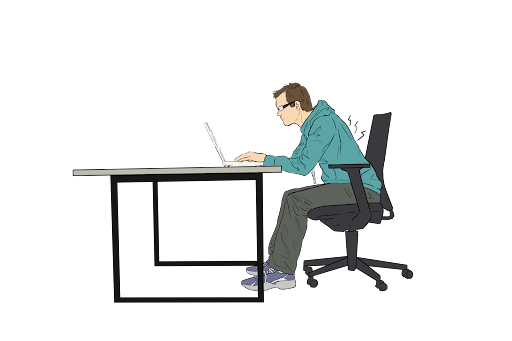A Sedentary Society
March, 2020
Our society as a whole is becoming increasingly sedentary, but nowhere more than at school. PHS students go to school and sit for six hours or more, before going home to sit for another six hours to study and fulfil various responsibilities, most of which are completed from a desk. Sitting for such a large fraction of the day is unhealthy. Sedentary behavior is linked to many chronic diseases and conditions as well as decreased creativity and intelligence. The human body responds badly to extended sitting because maintaining the same position all day is unnatural, and
graphic: Jennifer Ren inevitably leads to an imbalance. Slumping back in an uncomfortable metal chair all day accelerates spinal disk degeneration, among other problems which lead to pain and injury later in life.
One might think that exercise fixes the problems of sitting too much, but it doesn’t. According to an article in Harvard Health Publishing from 2015, an analysis of 47 studies showed that sitting for extended periods of time is associated with adverse health effects regardless of physical activity. If you sit all day, you are more likely to die young, even if you work out with perfect consistency. This isn’t to say that exercise is unimportant; it has a variety of health benefits both physically and mentally, but it doesn’t fix this particular problem.
Though standing desks might reduce time spent sitting, they create problems of their own. Standing still for extended periods of time puts strain on the legs that can lead to swelling or even injury. The problem here is the same; staying in the same position for a long period of time is bad. The best way forward is a lifestyle change; we should all regularly vary our position throughout the day.
The nature of high school is what causes a lot of kids to adopt sedentary lifestyles. High schools need to allow kids to get up and move around in class if they feel tired or unable to concentrate. If a student wants to stand or sit on the floor for part of class, they should be allowed to as long as they are still paying attention and not disturbing their classmates. Opportunities for kids to get up and move around as part of the lessons could also improve class participation, as well as giving the kids the chance to change their position. Of course, as teens, we ourselves also have a responsibility to make sure we move around and reposition ourselves and if we absolutely must sit for a long uninterrupted interval of time, sit up straight. The part of the brain that processes movement also processes learning, so learning will actually be easier for us if we move around more.
To achieve a state of optimal health, we should combine traditional exercise with smaller changes in movement and good positioning throughout the day. Exercise is for strength, cardiovascular health, and weight maintenance, while microactivity and position changes are to promote spine health and avoid imbalance. It is essential to remember that physical self-care isn’t limited to time spent in the gym or training for sports. During your entire day, you should be thinking about how to make healthy choices in movement and positioning. We don’t have to allow ourselves to become a sedentary society.